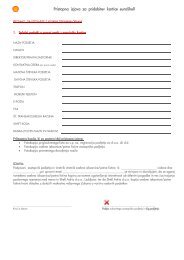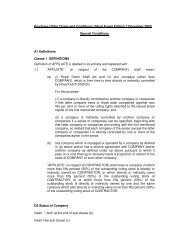OBEN GAS DEVELOPMENT PROJECT
OBEN GAS DEVELOPMENT PROJECT
OBEN GAS DEVELOPMENT PROJECT
Create successful ePaper yourself
Turn your PDF publications into a flip-book with our unique Google optimized e-Paper software.
Chapter Four Associated and Potential Environmental Impacts<br />
Great: A big effect on the social environment. There is permanent disruption to communal lifestyle.<br />
The local culture and the societal structure suffer greatly. There is now a fundamental<br />
disagreement between the company and its stakeholders that destabilizes the companystakeholder<br />
relationship. This may affect the speed and effectiveness of future decisionmaking<br />
processes.<br />
Extreme: A massive effect on the social environment. There is sustained large disruption of and<br />
changes to the lifestyle of a community leading to a reduction in quality of life. Impacts have<br />
become a concern for all stakeholder groups, irreversible damage to social structure,<br />
traditional culture, and infrastructure and total breakdown of stakeholder relationships.<br />
Definitions for the potential consequence of health impacts<br />
Hardly any: These are mere nuisances, not affecting work performance or causing disability, e.g.<br />
non-toxic dusts (as an acute hazard), short time sleep disturbance. There is no need to see<br />
medical services or a doctor. These health effects will disappear.<br />
Little: Illnesses that will need the attention of medical services/doctor. They need only a few days to<br />
fully recover and will not have led to chronic diseases, e.g., colds, chicken pox, skin infections<br />
and irritants, or many food poisoning bacteria.<br />
Considerable: Diseases (agents) capable of irreversible health damage causing permanent partial<br />
disability without loss of life. These health effects will need prolonged continuous or<br />
intermittent medical attention. e.g., hypertension, obesity, noise induced hearing loss, chronic<br />
back injuries caused by poor manual handling tasks or inactivity, chronic infections (like sexual<br />
transmitted diseases, schistosomiasis, hepatitis A), chronic skin diseases or respiratory<br />
system diseases like asthma caused by external agents and stress.<br />
Great: Permanent total disability or low number of fatalities: diseases capable of irreversible damage<br />
with serious disability. Low infectious communicable diseases like Ebola, SARS, Avian Flu,<br />
parasitic diseases (sleeping sickness), alcoholism and drug abuse, road traffic accidents,<br />
cancer caused by known human carcinogens (small exposed population), malnutrition, heat<br />
stroke, severe psychological stress leading to suicide.<br />
Extreme: Multiple fatalities: diseases with the potential to cause multiple fatalities: highly infectious<br />
diseases like tuberculosis, hepatitis B, HIV/AIDS, parasitic diseases as malaria, diseases<br />
caused by acute toxins (hydrogen sulphide, carbon monoxide), cancers caused by human<br />
carcinogens (large exposed population).<br />
Stage 4: Degree of significance<br />
Table 4.4 shows the impact significance with associated impact rating.<br />
4-4

















